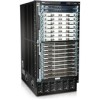Dell PowerConnect J-8216 Hardware Guide - Page 88
Table 34: Cabinet Requirements and Specifications for a J-EX8216 Switch
 |
View all Dell PowerConnect J-8216 manuals
Add to My Manuals
Save this manual to your list of manuals |
Page 88 highlights
Dell PowerConnect J-Series J-EX8216 Ethernet Switch Hardware Guide Table 34: Cabinet Requirements and Specifications for a J-EX8216 Switch Cabinet Requirement Guidelines for the J-EX8216 Switch Cabinet size and clearance Cabinet airflow requirements NOTE: The J-EX8216 switch can be installed only on a four-post rack or cabinet. Installation on a two-post rack is not supported. • The minimum cabinet size for accommodating a J-EX8216 switch is 23.62 in. (60 cm) wide and 36.0 in. (91.4 cm) deep. Large cabinets improve airflow and reduce the chance of overheating. To accommodate a single J-EX8216 switch in a four-post rack, the cabinet must be at least 21 U high (or 22 U if you install the power cord tray, which is optional for the four-post rack). A U is the standard rack unit defined in Cabinets, Racks, Panels, and Associated Equipment (document number EIA-310-D) published by the Electronics Industry Association (http://www.eia.org). • With adequate cooling air and airflow clearance, you can stack two J-EX8216 switches in a cabinet with a four-post rack that has at least 42 U of usable vertical space. (44 U are required if you install the optional power cord tray.) In all cases, the rack must meet the strength requirements to support the weight of the installed switches. When you mount the switch on a cabinet, ensure that ventilation through the cabinet is sufficient to prevent overheating. Consider the following requirements list when planning for chassis cooling: • Ensure that the cool air supply you provide through the cabinet adequately dissipates the thermal output of the switch (or switches). • Ensure that the cabinet allows the chassis hot exhaust air to exit the cabinet without recirculating into the switch. An open cabinet (without a top or doors) that employs hot air exhaust extraction from the top allows the best airflow through the chassis. If the cabinet contains a top or doors, perforations in these elements assist with removing the hot air exhaust. For an illustration of chassis airflow, see "Clearance Requirements for Airflow and Hardware Maintenance for a J-EX8216 Switch" on page 73. • The switch fans exhaust hot air through the right side of the chassis (the left side when you face the front of the chassis, where the fan tray slides in). Install the switch in the cabinet in a way that maximizes the open space on the fan tray side of the chassis. This maximizes the clearance for critical airflow. • Route and dress all cables to minimize the blockage of airflow to and from the chassis. • Ensure that the spacing of rails and adjacent racks allows for the proper clearance around the switch and rack as specified in "Clearance Requirements for Airflow and Hardware Maintenance for a J-EX8216 Switch" on page 73. Related • Rack-Mounting and Cabinet-Mounting Warnings for J-EX Series Switches on page 215 Documentation 72















